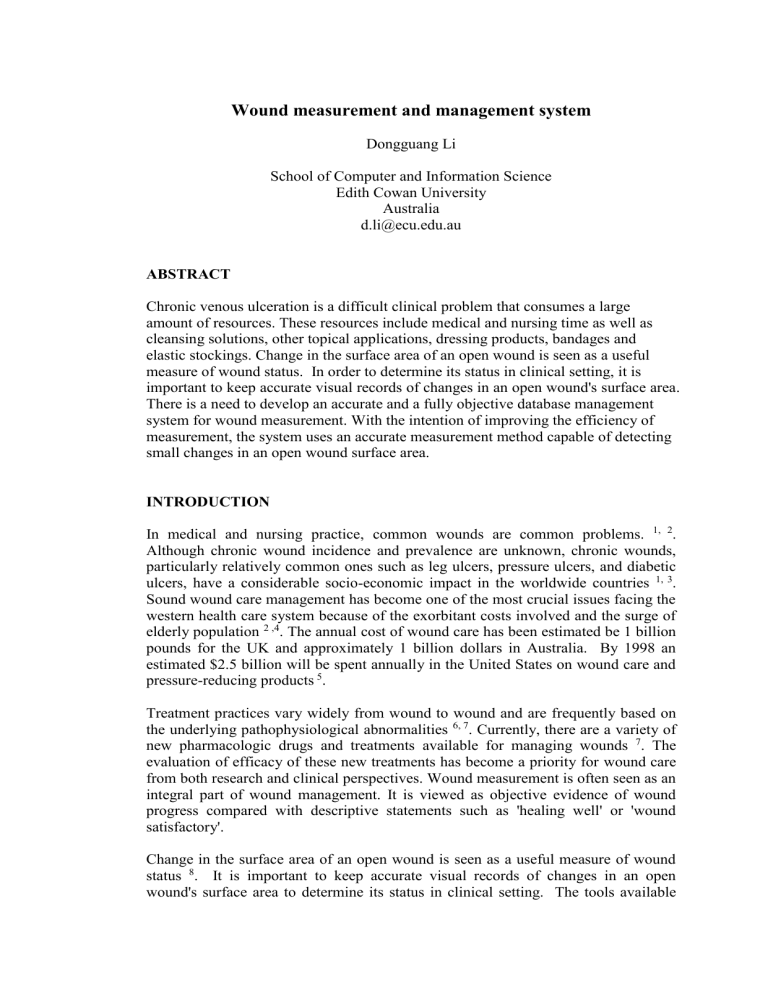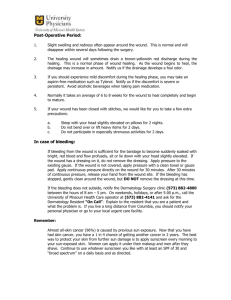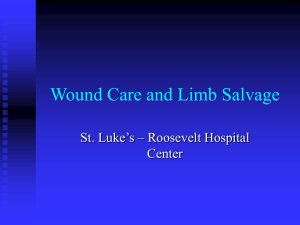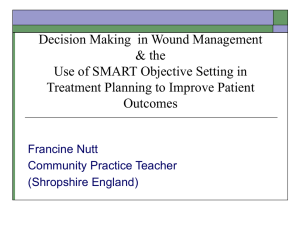005-0008 - Pomsmeetings.org

Wound measurement and management system
Dongguang Li
School of Computer and Information Science
Edith Cowan University
Australia d.li@ecu.edu.au
ABSTRACT
Chronic venous ulceration is a difficult clinical problem that consumes a large amount of resources. These resources include medical and nursing time as well as cleansing solutions, other topical applications, dressing products, bandages and elastic stockings. Change in the surface area of an open wound is seen as a useful measure of wound status. In order to determine its status in clinical setting, it is important to keep accurate visual records of changes in an open wound's surface area.
There is a need to develop an accurate and a fully objective database management system for wound measurement. With the intention of improving the efficiency of measurement, the system uses an accurate measurement method capable of detecting small changes in an open wound surface area.
INTRODUCTION
In medical and nursing practice, common wounds are common problems.
1, 2
.
Although chronic wound incidence and prevalence are unknown, chronic wounds, particularly relatively common ones such as leg ulcers, pressure ulcers, and diabetic ulcers, have a considerable socio-economic impact in the worldwide countries
1, 3
.
Sound wound care management has become one of the most crucial issues facing the western health care system because of the exorbitant costs involved and the surge of elderly population
2 ,4
. The annual cost of wound care has been estimated be 1 billion pounds for the UK and approximately 1 billion dollars in Australia. By 1998 an estimated $2.5 billion will be spent annually in the United States on wound care and pressure-reducing products
5
.
Treatment practices vary widely from wound to wound and are frequently based on the underlying pathophysiological abnormalities
6, 7
. Currently, there are a variety of new pharmacologic drugs and treatments available for managing wounds
7
. The evaluation of efficacy of these new treatments has become a priority for wound care from both research and clinical perspectives. Wound measurement is often seen as an integral part of wound management. It is viewed as objective evidence of wound progress compared with descriptive statements such as 'healing well' or 'wound satisfactory'.
Change in the surface area of an open wound is seen as a useful measure of wound status
8
. It is important to keep accurate visual records of changes in an open wound's surface area to determine its status in clinical setting. The tools available
for the measurement of the surface area of a wound are described as either invasive or noninvasive, depending on the level of intervention required by the technique to obtain the data
8
. Currently, there are several noninvasive techniques such as ultrasound, magnetic resonance or stereophotometry 9, 10 . More clinically accessible, however, are linear measurement and acetate tracing
8, 11
.
Tracing is a simple method of wound measurement. It involves using acetate paper or an occlusive dressing and maculating the area of the wound when traced by pen on to paper by conventional planimetric analysis
8
. However, planimetry has an inherent variability of the measuring wounds
10, 12
. The method of planimetry has been challenged by more sophisticated techniques, such as computer assisted technology, video-image analysis and laser imaging processing
11-13
. Despite the wide range of available techniques, clinical methods that are both accurate for the researcher and minimally invasive and comfortable for the patient are lacking 8 . There is, therefore, a genuine need to develop an accurate, reliable and clinical acceptable technique to wound management.
METHODS
First of all, we designed an user interface based on PC. Figure 1 shows the Use Case
(user view and communication) diagram for the Wound Measurement Software.
Figure 1 Use Case diagram
Page 2 of 8
As shown in Figure 1 the user first interacts with the login screen, and then with the main menu (if the user is identified to the system). Conduct the wound measurement would be the next step. The wound size assessment should include length, width, area and perimeter. This paper mainly describes the database design. One can find more on the details of the methods for calculating a wound size and area and methods for manipulating images one pixel at a time from the relevant reference publications. Figure 2 shows the interface for the wound measurement.
Figure 2 Wound Measurement user-interface
The program enables the user to calculate the linear distance (width and length) of an image. The mouse is used to trace the cursor around the image outline (perimeter).
The subsequent automatic calculation of the wound size and assessment of the wound’s coloring is more accurate and repeatable (reliable) than manual methods
Page 3 of 8
alone. Manual calibration of the measurement can be carried out to increase wound assessment accuracy and reliability.
In addition, at any time, a patient’s wound images and image data (see Figure 3) may be viewed in chronological order for the purpose of comparison. This provides a visual and informative record of changes to the wound over time (for example, charts can be viewed and information printed).
Figure 3 Form Wound Images
Each image in a patient record includes automatically calculated data for wound size.
The user can also select the colour, degree of pain and stage of the ulcer. The system can also record any notes (see Figure 4) made by the practitioner.
Page 4 of 8
Figure 4 The Image Record Panel
Finally, Wound Measurement Software provides all the features necessary to work with databases, such as entering new data, and modifying or viewing existing data.
Figure 5 shows the Physician form.
Figure 5 Physician Form
Page 5 of 8
DATABASE DESIGN
Figure 6 shows the Entity Relationship (ER) diagram for the system.
Figure 6 ER diagram
The configurations of the MS Access database are as follows:
There is a one-to-many relationship between the Patient table and the Wound table.
There is a one-to-many relationship between the Wound table and the Image table.
There is a many-to-one relationship between the Assessment table and the
Wound table.
There is a one-to-many relationship between the Physician table and the
Assessment table.
There is a one-to-many relationship between the Speciality table and the
Physician table.
Figure 7 shows the relationships in six tables from the dbwound.mdb (Microsoft
Access database).
Page 6 of 8
Figure 7 dbwounds.mdb database
CONCLUSION
The primary objective of the research was the development of a software application for wound measurement. The developed software program allows clinicians to measure the progress of a wound.
The Wound Measurement Software program imports images of wounds, and then uses a unique measurement approach to accurately measure wound sizes. The MS access database was used to store and manage the wound data. The result of this study shows that this measurement system is able to precisely detect the width, length and area of an image. As the database system is popular and simple to use, we can easily perform all the essential features necessary to monitor wound healing.
There are a number of areas where the research could be expanded, such as the quantitative and qualitative testing against existing methods, clinical trials using sufficient data, and the user (practitioner) testing. There is also a consideration of establishing a web enable database system for the wound measurement.
Page 7 of 8
REFERENCES
1.
Bates-Jensen BM. Chronic wound assessment. Nursing Clinics of North
America. 34(4):799-845,1999.
2.
Benbow M. The Chronic Wound Support Service [editorial]. Journal of Tissue
Viability. 9(2):43-4, 1999.
3.
Neil JA. Munjas BA. Living with a chronic wound: the voices of sufferers.
Ostomy Wound Management. 46(5):28-34, 36-8, 2000.
4.
Gallagher SM. Culture, health, and healing. Ostomy Wound Management.
46(6):16-8, 2000.
5.
Russell L. The importance of wound documentation and classification. British
Journal of Nursing. 8(20):1342-3, 1999.
6.
Boxer E. Maynard C. The management of chronic wounds: factors that affect nurses' decision-making. Journal of Wound Care. 8(8):409-12, 1999.
7.
Kantor J. Margolis DJ. The accuracy of using a wound care specialty clinic database to study diabetic neuropathic foot ulcers. Wound Repair Regeneration.
8(3):169-73, 2000.
8.
Williams C. Wound-measuring methods. Community Nurse. 3(8):46-8, 1997.
9.
Ho DQ. Bello YM. Grove GL. Manzoor J. Lopez AP. Zerweck CR. Pierce EA.
Werkheiser JL. Phillips TJ. A pilot study of noninvasive methods to assess healed acute and chronic wounds. Dermatologic Surgery. 26(1):42-9, 2000.
10.
Plassmann P. Jones TD. MAVIS: a non-invasive instrument to measure area and volume of wounds. Measurement of Area and Volume Instrument System.
Medical Engineering & Physics. 20(5):332-8, 1998.
11.
Bahmer FA. Wound measurement made truly simple by point counting [letter; comment]. Archives of Dermatology. 135(8):991-2, 1999.
12.
Kanthraj GR. Srinivas CR. Shenoi SD. Suresh B. Ravikumar BC. Deshmukh RP.
Wound measurement by computer-aided design (CAD): a practical approach for software utility [letter; comment]. International Journal of Dermatology.
37(9):714-5, 1998.
13.
Lagan KM. Dusoir AE. McDonough SM. Baxter GD. Wound measurement: the comparative reliability of direct versus photographic tracings analyzed by planimetry versus digitizing techniques. Archives of Physical Medicine &
Rehabilitation. 81(8):1110-6, 2000.
Page 8 of 8








